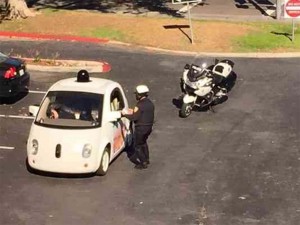
Consumer Watchdog wants federal rules mandating steering wheels as well as brake and gas pedals for autonomous vehicles.
Friend and foe alike finally got to put in their two cents worth about the future of autonomous driving and the vehicles that will be careening down U.S. roadways at a forum in California today.
Federal officials are holding several of these events as they seek opinions from the public about self-driving vehicles. The event came just a day after Google, Uber and Lyft have joined forces with Volvo and Ford in establishing “The Self-Driving Coalition for Safer Streets,” which has recruited David Strickland, long-time safety watchdog and former head of the U.S. National Highway Traffic Safety Administration.
“Self-driving vehicle technology will make America’s roadways safer and less congested,” Strickland said in a statement. “The best path for this innovation is to have one clear set of federal standards, and the Coalition will work with policymakers to find the right solutions that will facilitate the deployment of self-driving vehicles.”
The forum followed an initial hearing in March where opponents asked for an acceleration in the process of determining the rules, while opponents called for an abundance of caution in the testing of what they view as emerging technologies.
During the California event today, Chris Urmson, lead executives on Google’s autonomous vehicle project, implored the federal government to establish the rules for vehicle testing. He noted that developing these vehicles difficult enough without having to play by different sets of rules in different states.
Adding “15 states propose bespoke laws over the last 12 months, all of which have a different scope and different definitions. Vehicle safety standards are not the expertise of the states and expecting them to take on this role will only lead to inconsistent safety requirements. We would like NHTSA to be the expert authority for the nation on this issue.”
(Carmakers, tech companies form self-driving auto alliance. For more, Click Here.)
As quickly as Urmson urged those in attendance to settle these matters quickly, opposition groups made it known that the government should not be quick to adopt rules allowing for vehicles without steering wheels, brakes and accelerators on America’s streets.
“Deploying a vehicle today without a steering wheel, brake, accelerator and a human driver capable of intervening when something goes wrong is not merely foolhardy. It is dangerous,” said Consumer Watchdog’s John M. Simpson.
To dramatize the point, he gave Urmson a steering wheel. Simpson, the group’s Privacy Project Director, also gave them 10 questions about Google’s self-driving project to answer.
The questions largely centered on the shortcomings or perceived shortcomings of Google’s vehicle, such as “Will Google publish a complete list of real-life situations the cars cannot yet understand, and how you intend to deal with them?”
Simpson criticized the tech giant’s lack of transparency about problems with the cars, pointing out that a Google vehicle was involved in a collision with a bus in February and that while video recorded by the bus was released to the public, Google has not released any information related to the incident.
(Click Here for details about the pushback feds expect to get about new autonomous vehicle rules.)
These vehicles are still in the testing phase, but are seen by many as a critical component to reducing the number of deaths on U.S. roadways annually. NHTSA Administrator Mark Rosekind has been banging the drum for the advancement of autonomous vehicles
Urmson took note of the criticism about the shortcomings of self-driving vehicles currently, but believes that despite any errors made by autonomous vehicles – Google cars have driven millions of test miles in several states and have been blamed for just one minor accident – they’ll offset the more than 33,000 fatalities in the U.S. annually.
“We believe that our country cannot go slow on safety,” Urmson said, according to USA Today. “Despite the progress made, our roads are still unsafe for people. Ninety people die on U.S. streets every day due to motor vehicle accidents, and that number increased by about 8% in 2015 alone. The concern should not be that (autonomous car) technology comes too soon, but that it comes too late.”
Simpson, however, remained unimpressed by Urmson’s testimony, pointing out that the cars are not always capable of “seeing” pedestrians and cyclists, traffic lights, low-hanging branches, or the proximity of parked cars, suggesting too great a risk of serious accidents involving pedestrians and other cars. The cars also are not capable of reacting to reckless behavior of others on the road quickly enough to avoid the consequences.
“NHTSA officials have repeatedly said safety is the agency’s top priority,” he said. “You must not allow your judgment to by swayed by rosy, self-serving statements from companies like Google about the capabilities of their self-driving robot cars.
(Google and Volvo are expanding their autonomous vehicle testing. Click Here for the latest.)
“NHTSA has said that autonomous vehicle technology is an area of rapid change that requires you to remain ‘flexible and adaptable.’ Please ensure that flexibility does not cause you to lose sight of the need to put safety first. Innovation will thrive hand-in-hand with thoughtful, deliberate regulation. Your guidance for the states on autonomous vehicles must continue to require a human driver who can intervene with a steering wheel, brake and accelerator when necessary.”
